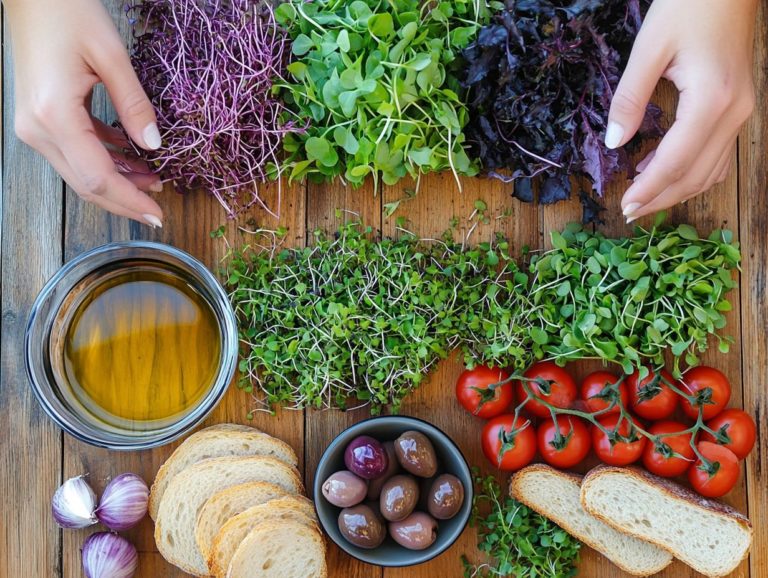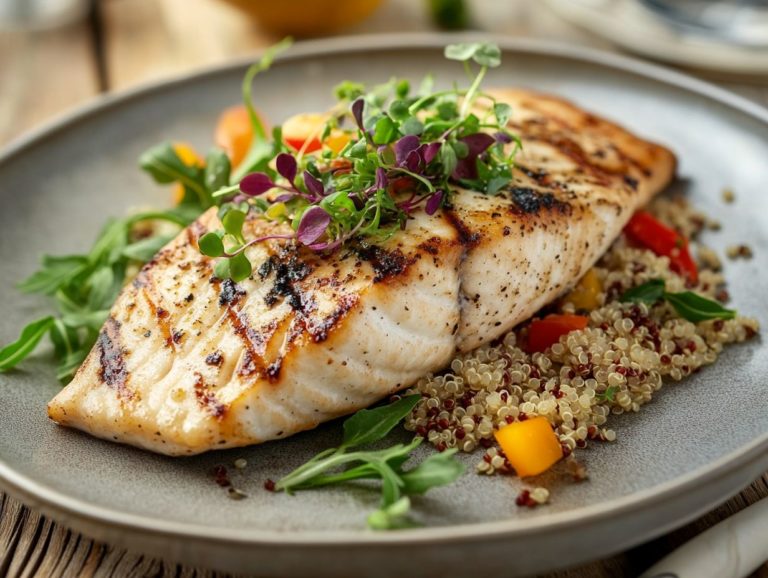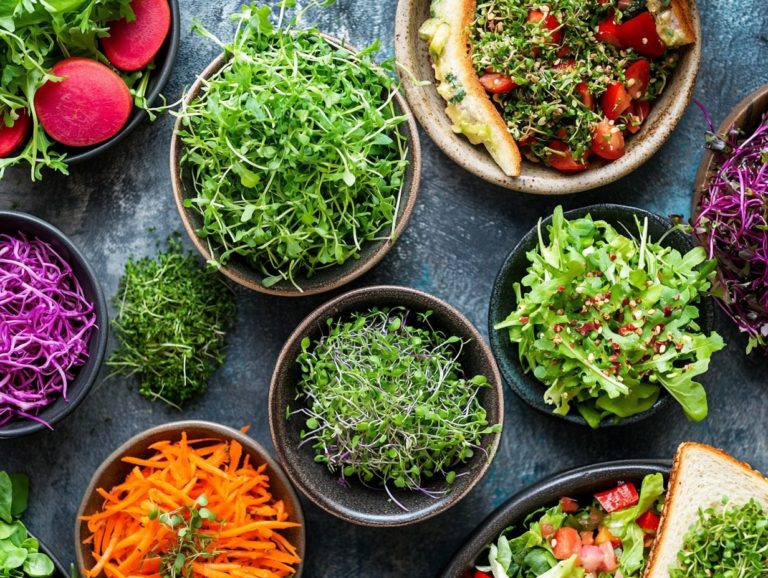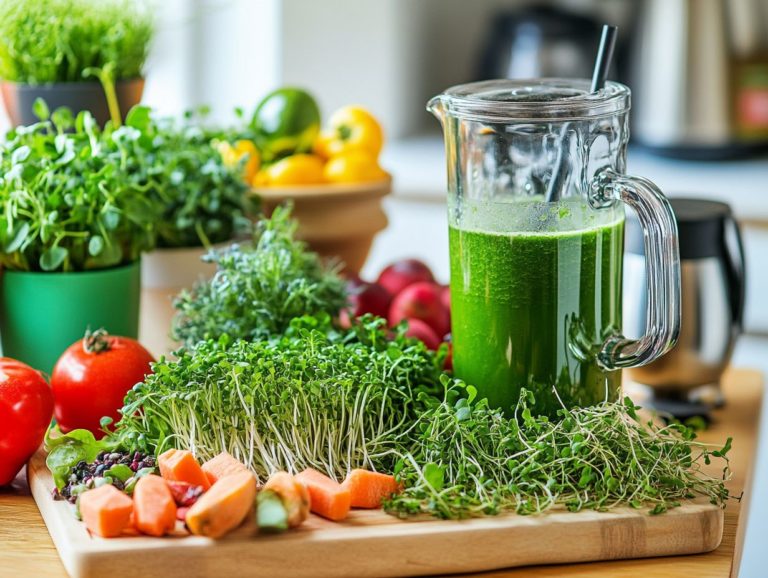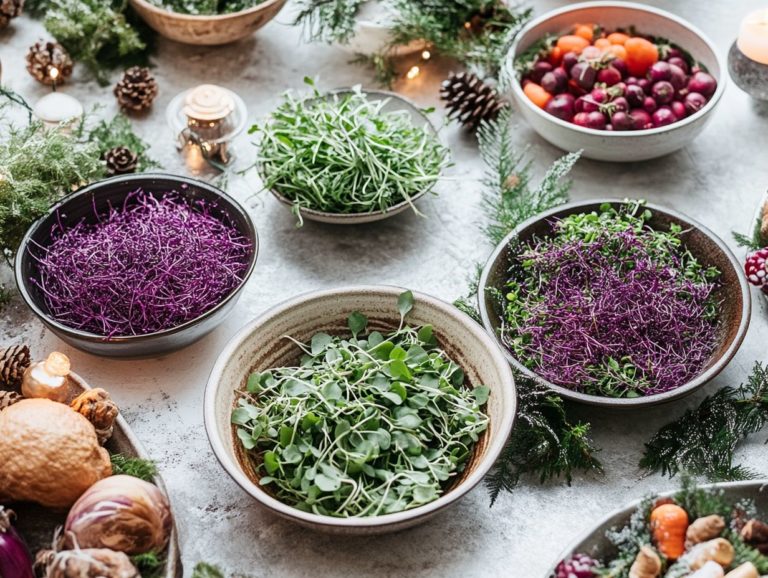98. How to Create Microgreen Infused Sauces
Microgreens are miniature, flavorful plants brimming with nutrients. They are ready to elevate your culinary creations to new heights.
This article delves into the benefits of incorporating microgreens into your sauces. You will discover effective techniques for infusing these vibrant greens into your dishes. Explore popular microgreens to experiment with and receive invaluable tips for growing your own at home!
Contents
Key Takeaways:
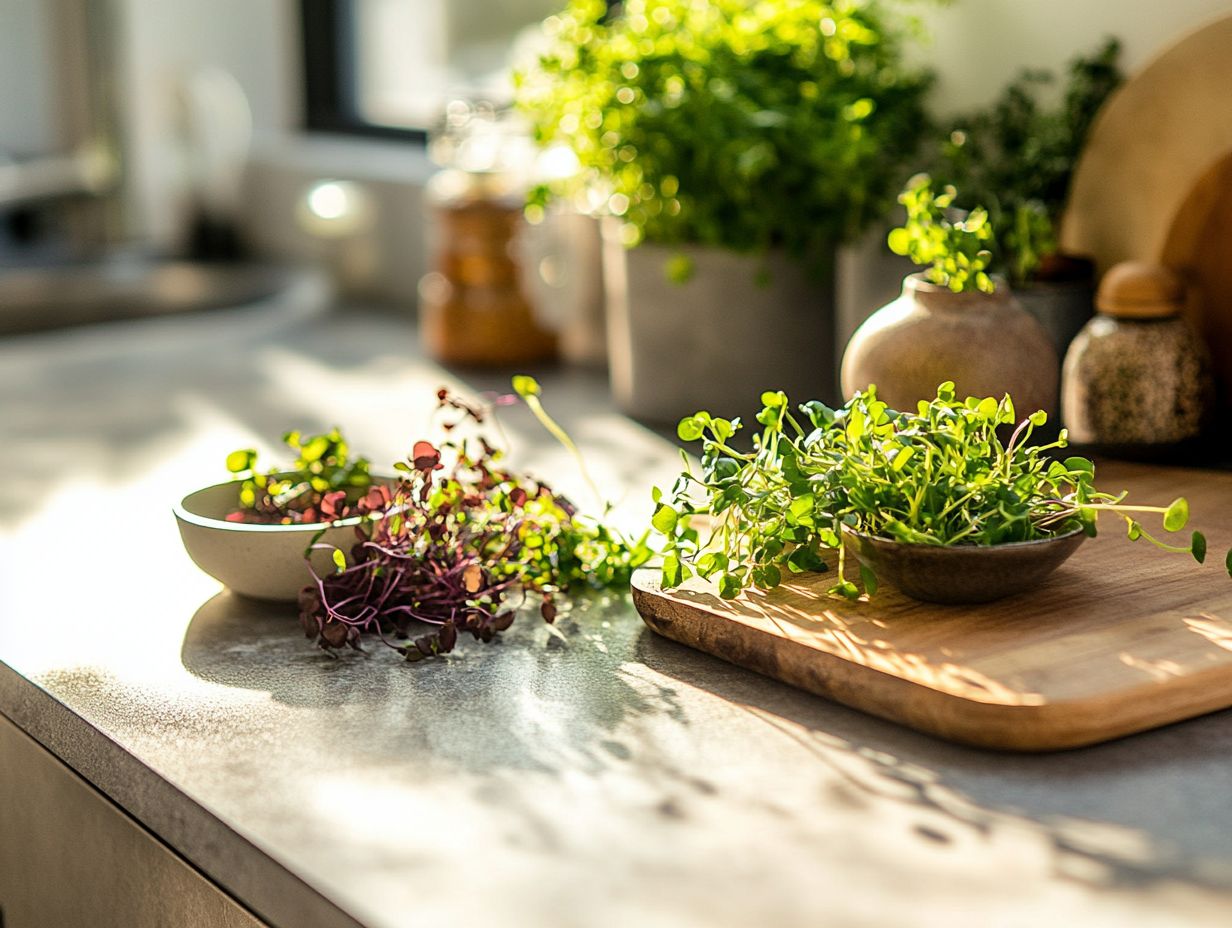
- Discover the benefits of incorporating microgreens into sauces, such as enhanced flavor and increased nutritional value.
- Learn various techniques for infusing and blending microgreens into sauces, creating unique and delicious flavors.
- Explore popular types of microgreens to experiment with in sauces. Get tips for growing your own microgreens at home for maximum freshness and flavor.
What are Microgreens?
Microgreens are young, edible plants. You can harvest them just after the first true leaves have developed. They bring a delightful array of flavors and vibrant colors to your culinary creations.
These greens, like radish and beet microgreens, are celebrated for their impressive nutritional profiles. They are packed with vitamins A, C, and K, making them a great choice for health-conscious food enthusiasts. You can sprinkle them in salads, layer them in sandwiches, blend them into smoothies, or stir them into sauces.
Often grown in soil or hydroponically, these delicate greens thrive in well-draining conditions. Whether you choose to cultivate them indoors or outdoors, their adaptability shines across the seasons. Some popular varieties include basil, cilantro, and broccoli microgreens, each offering unique flavors.
Chefs love using microgreens as garnishes. They add sophistication to gourmet dishes, while home cooks appreciate their ease of cultivation, often growing them right on their windowsills.
Many microgreens are loaded with antioxidants and essential nutrients. Some even boast anti-inflammatory properties, making them a proactive step toward healthier living.
Benefits of Using Microgreens in Sauces
Incorporating microgreens into your sauces offers a wealth of benefits. They elevate both taste and nutritional value while adding a vibrant touch to your culinary creations.
These petite greens deliver a delightful burst of flavor and a robust array of vitamins, antioxidants, and essential nutrients. They transform ordinary dishes into extraordinary masterpieces.
With a selection of microgreens, such as arugula and thyme, you can experiment and craft unique flavor profiles. This turns sauces from mere condiments into integral components of a healthy, balanced meal.
Nutritional Value and Flavor Enhancements
Microgreens are packed with vitamins and antioxidants that can elevate any dish, especially in sauces and dressings. These tiny powerhouses, like beet and radish microgreens, offer essential nutrients that support your health while enhancing your meals’ flavor profile.
Their concentrated taste and varied textures add depth to sauces, making them an invaluable ingredient for anyone eager to craft delicious and healthful culinary experiences.
By including these greens in your recipes, you boost your nutritional intake and introduce exciting flavors that can complement different sauce types. For example, basil microgreens add a refreshing brightness to pesto, while sunflower microgreens contribute a delightful nutty undertone to dressings.
With their vibrant colors and diverse flavors, microgreens empower you whether you’re an amateur cook or a seasoned chef to enhance your culinary repertoire. Enjoy healthy eating that is undeniably flavorful!
How to Incorporate Microgreens into Sauces
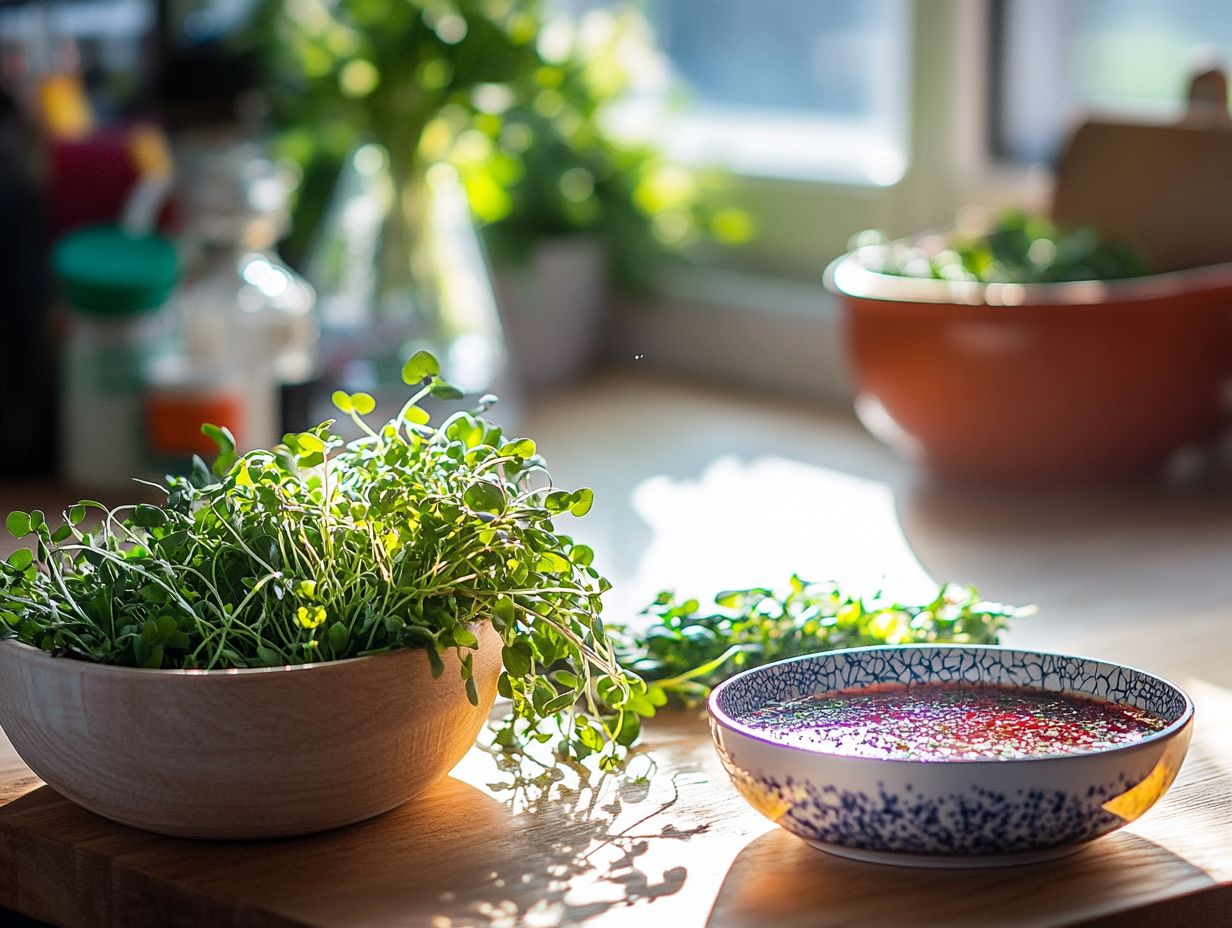
Incorporating microgreens into your sauces is a simple yet transformative process that can elevate both flavor and nutritional value. This makes them essential in any cooking skills.
Whether you’re crafting a basic dressing or a more intricate sauce, the versatility of microgreens opens the door to countless applications. They enhance everything from a vibrant vegan BBQ bowl to an exquisite gourmet avocado toast.
Techniques like blending, infusing, and garnishing with microgreens can invigorate your dishes. They offer visual allure and a nutritious lift that aligns perfectly with modern culinary trends.
Techniques for Infusing and Blending
Infusing microgreens into your sauces is an art that requires specific techniques to fully unleash their flavor and nutritional potential. This creates a truly rich culinary experience.
You can unlock deeper flavors by using methods like cold-pressing (extracting oils without heat) or saut ing the microgreens first. For example, adding freshly chopped basil microgreens to your pesto not only elevates the aroma but also imparts a fresh, peppery bite that enhances the dish’s overall flavor profile.
Dive right into experimenting with different oils to achieve unique textures and richness. A drizzle of infused olive oil mixed with finely blended pea microgreens can transform a simple dressing into something truly exquisite. Always start with a small amount of microgreens and adjust to your taste, as their concentrated flavors can significantly alter the final product.
Popular Microgreens for Sauces
You have a remarkable selection of popular microgreens at your fingertips, each capable of enhancing sauces with distinct flavors and textures.
Imagine the peppery kick of radish microgreens paired with the earthy notes of beet microgreens! These ingredients do more than elevate taste they also provide a nutritional boost that aligns with health-conscious eating.
Their vibrant colors and remarkable freshness can turn ordinary sauces into extraordinary accompaniments. This makes them essential for both home cooks and professional chefs aiming to enhance their culinary skills.
Types of Microgreens to Experiment With
Experimenting with different types of microgreens opens up a world of flavor possibilities in your cooking skills, enhancing both your sauces and dishes.
Incorporating varieties like black currants for sweetness or nettles for a unique herbal twist can inspire your creativity in the kitchen. Explore diverse flavors and textures of microgreens to elevate your recipes, from simple beet salads to complex Asian noodle dishes.
Adding vibrant arugula microgreens introduces a peppery note to your sandwiches. Meanwhile, sunflower greens provide a delightful crunch, perfect for brightening up grain bowls. If you’re seeking a pop of color and zest, sprinkle radish microgreens atop tacos or incorporate them into your dressings.
Each microgreen boasts its own distinct profile, inviting you to experiment with combinations that enhance not only flavor but also the visual appeal of your meals. Dive into these diverse varieties, and your kitchen transforms into a playground for innovation, welcoming new flavors and delightful surprises into your everyday cooking.
Tips for Growing Your Own Microgreens
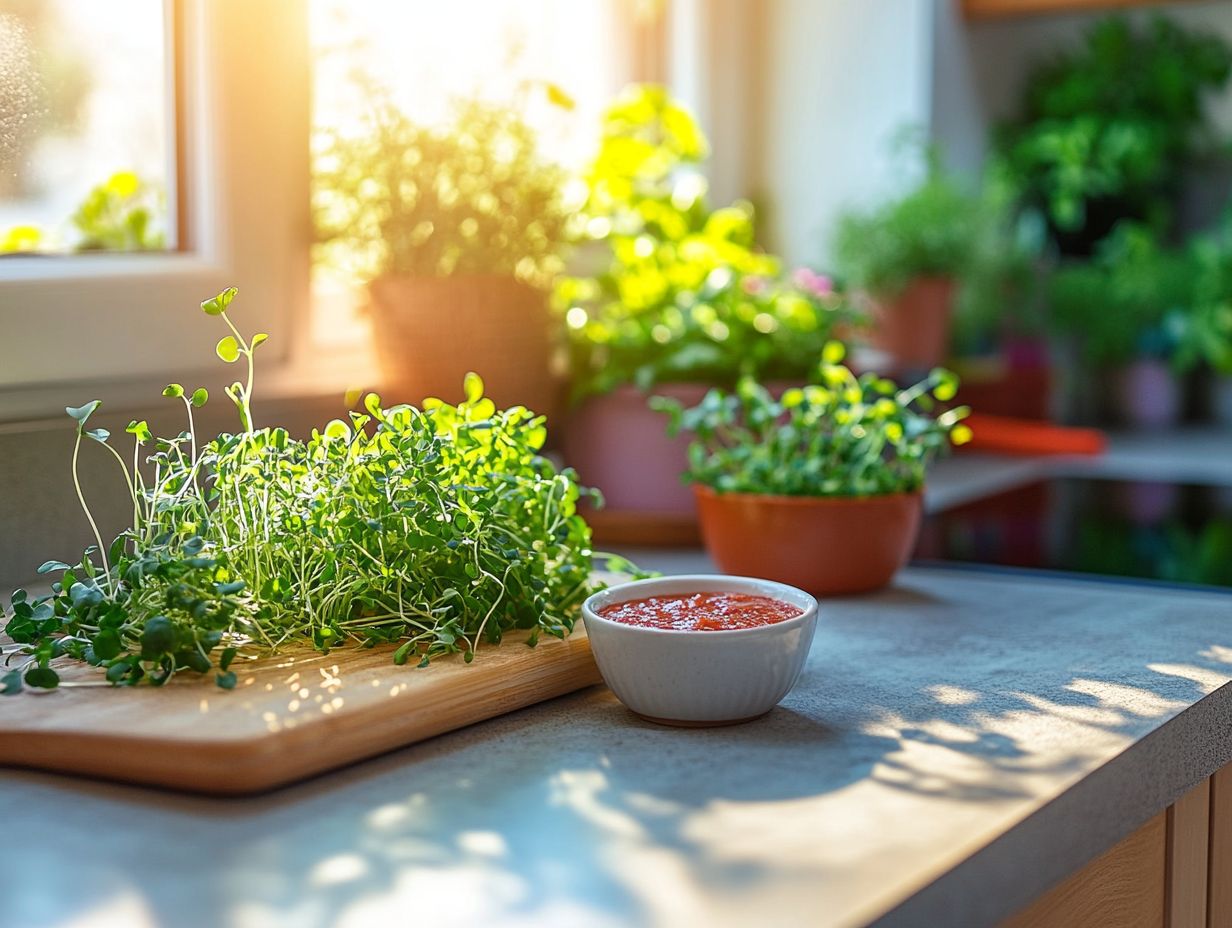
Growing your own microgreens at home is an enriching experience. It grants you access to fresh, nutrient-dense greens while elevating your culinary endeavors.
With straightforward techniques and minimal space requirements, you can easily cultivate a variety of microgreens, such as radish and beet, right in your kitchen or garden. This not only guarantees unparalleled freshness but also opens the door to exciting flavor experiments in sauces, salads, and smoothies.
It’s a sustainable approach to infusing your meals with vibrant, home-grown produce that enhances both taste and nutrition.
Step-by-Step Guide to Growing Microgreens at Home
Creating a thriving microgreens garden at home is a delightful endeavor. You can harvest delicious, nutritious greens for a variety of tasty meals. Start by selecting your favorite microgreens, like arugula or radish. Gather the essentials trays, soil, and seeds.
With this step-by-step guide, you’ll soon cultivate fresh microgreens that elevate everything from simple salads to gourmet sauces. For inspiration, check out 99. 8 delicious microgreen ideas for holiday parties. They effortlessly add both flavor and nutrition to your meals.
These tiny powerhouses enhance the visual appeal of your dishes. They deliver a concentrated dose of vitamins and minerals. To embark on this gardening journey, prepare a well-draining soil mix. Ensure your trays have adequate drainage holes. Sow the seeds evenly, keeping the right spacing for each variety, and gently cover them with soil.
Water them carefully to avoid displacing the seeds. Place the trays in a warm spot with indirect sunlight. As your microgreens grow, monitor moisture levels without oversaturating the soil. Harvest them when they reach about two inches tall. This makes it easy to add these vibrant greens to your meals.
Recipes for Microgreen Infused Sauces
Exploring recipes for microgreen-infused sauces is a fantastic way to unleash your kitchen creativity. These sauces enhance the flavor profiles of your favorite dishes.
Get ready to craft a vibrant beet and spicy cucumber sauce or a robust chimichurri sauce brimming with microgreens. These culinary creations showcase the versatility of microgreens, inviting you to infuse their unique flavors into everyday meals.
These recipes not only elevate your dishes but also enrich them with essential nutrients. It’s a delightful win-win for both your palate and your health.
Delicious and Creative Sauce Ideas
Delicious and creative sauce ideas featuring microgreens can elevate your cooking. They bring an exciting array of flavors and health benefits to your beloved dishes. Experiment with a spicy avocado sauce or a light BBQ sauce enriched with fresh microgreens for a refreshing twist!
A zesty cilantro lime sauce will take your tacos to the next level. Combine ingredients like garlic, lime juice, and a handful of vibrant cilantro microgreens blended to perfection. Alternatively, consider a basil pesto infused with arugula microgreens to add a peppery kick to your pasta dishes or grilled vegetables. To enhance your dishes further, learn how to make microgreen infused oil, which can elevate flavors in various recipes. A silky tahini dressing accentuated with radish microgreens offers a rich, nutty flavor that complements grain bowls beautifully.
Each of these sauces invites you to unleash your creativity in the kitchen. You can explore diverse flavor profiles while seamlessly incorporating the health benefits of microgreens into your everyday meals.
Frequently Asked Questions
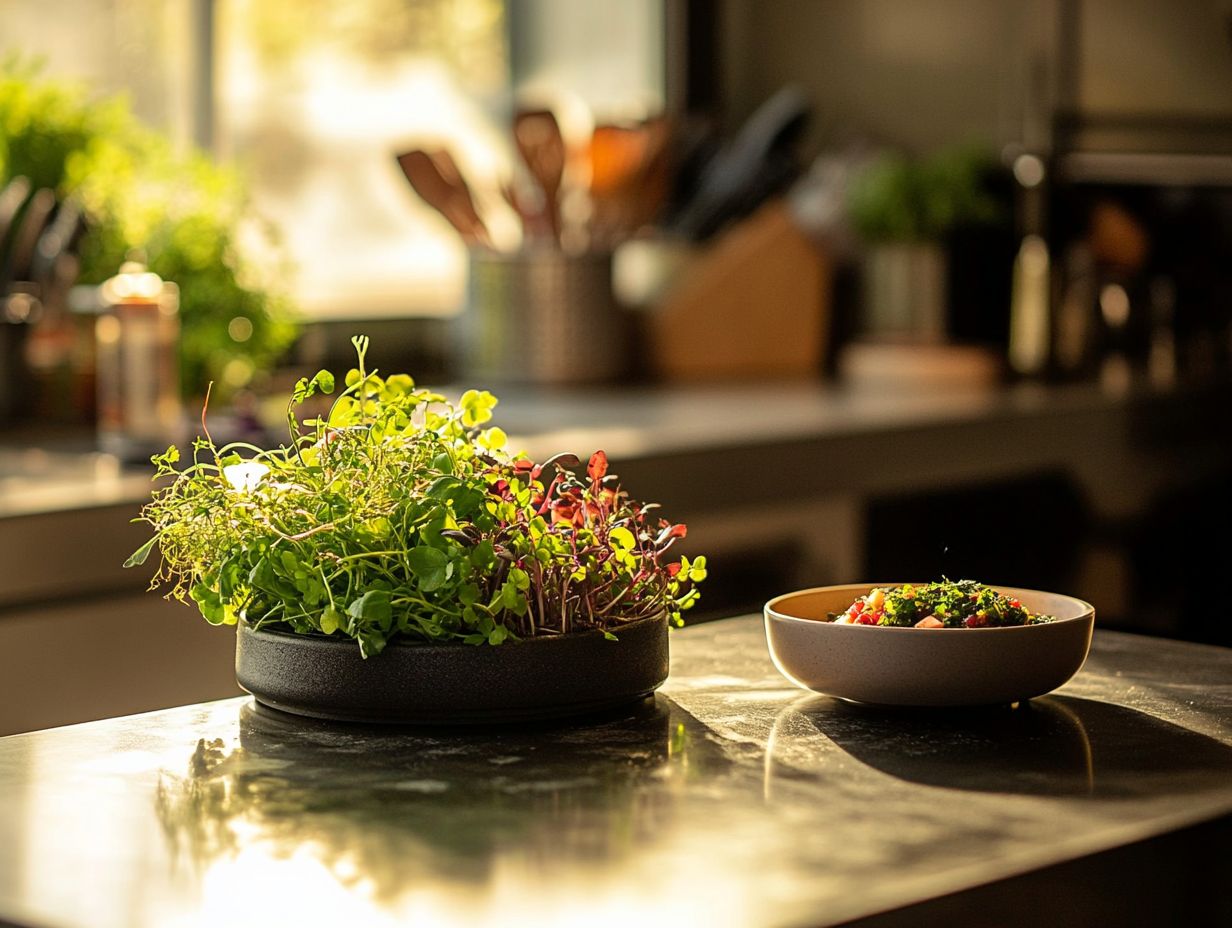
1. What are microgreen infused sauces?
Microgreen infused sauces are sauces made with microgreens. These young vegetable greens are harvested just after the first few leaves develop. They’re packed with flavor and nutrients, making them perfect for sauces.
2. How do I create microgreen infused sauces?
To make microgreen-infused sauces, first choose your microgreen. Then, blend the microgreens with other ingredients for a smooth sauce, or finely chop the microgreens and add them as a topping or garnish.
3. What type of microgreens work best for sauces?
For making microgreen infused sauces, use types with strong flavors, like radish, basil, or cilantro. These microgreens will add a burst of flavor to your sauces.
4. Can I use microgreen infused sauces in any recipe?
Yes! Microgreen infused sauces can be used in various recipes. They work well as a dip for vegetables or chips, a dressing for salads, or a topping for meats or pasta dishes.
5. Are microgreen infused sauces healthy?
Yes, microgreen infused sauces are a healthier alternative to traditional sauces. They’re a delicious and healthy upgrade to your meals!
6. How long can I store microgreen infused sauces?
Microgreen infused sauces can be stored in an airtight container in the refrigerator for up to a week. Consume them within a few days to enjoy the best flavor.

